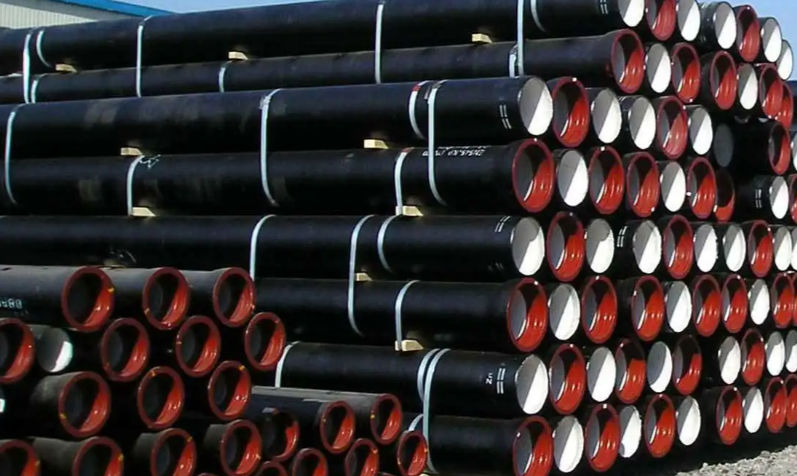Cutting ductile iron pipes is a common task in water and wastewater infrastructure projects. Due to their strength and durability, these pipes require specific tools and techniques to ensure clean, safe cuts.

🔧 Common Cutting Methods
1. Abrasive Wheel (Cut-Off Saw)
-
Description: Utilizes a rotating abrasive blade to slice through the pipe.
-
Ideal For: Straight cuts on pipes up to 12 inches in diameter.
-
Pros: Fast cutting speed; suitable for field use.
-
Cons: Generates sparks and debris; requires proper safety precautions.
2. Diamond Chain Saw
-
Description: Employs a diamond-encrusted chain to cut through the pipe.
-
Ideal For: Large diameter pipes; confined spaces.
-
Pros: Clean cuts; minimal debris.
-
Cons: Higher cost; requires specialized training.
3. Rotary Pipe Cutter
-
Description: A clamp-on tool that rotates around the pipe to make the cut.
-
Ideal For: Precise cuts on various pipe materials.
-
Pros: Portable; provides a clean, square cut.
-
Cons: May require multiple passes for larger diameters.
4. Hinged Pipe Cutter
-
Description: A manual tool that clamps onto the pipe and uses a ratcheting mechanism to cut.
-
Ideal For: Small to medium diameter pipes; tight spaces.
-
Pros: No power source needed; lightweight.
-
Cons: Limited to smaller pipe sizes; slower cutting process.
📏 Step-by-Step Cutting Guide
-
Measure and Mark:
-
Use a measuring tape to determine the exact length needed.
-
Mark the cut line around the circumference using a chalk line or pipe marker.
-
-
Secure the Pipe:
-
Place the pipe on a stable surface.
-
Use pipe supports or clamps to prevent movement during cutting.
-
-
Select the Appropriate Tool:
-
Choose a cutting method based on the pipe’s diameter and location.
-
-
Cut the Pipe:
-
Follow the manufacturer’s instructions for the chosen tool.
-
Maintain a steady pace to ensure a clean cut.
-
-
Deburr the Edges:
-
After cutting, use a file or deburring tool to smooth any rough edges.
-
⚠️ Safety Precautions
-
Always wear appropriate personal protective equipment (PPE), including gloves, safety glasses, and hearing protection.
-
Ensure the work area is clear of flammable materials when using cutting tools that generate sparks.
-
Follow all manufacturer guidelines for tool operation and maintenance.
📊 Comparison of Cutting Methods
| Method | Pipe Diameter | Speed | Cost | Best For |
|---|---|---|---|---|
| Abrasive Wheel | Up to 12″ | Fast | Moderate | Straight cuts in the field |
| Diamond Chain Saw | 12″ and above | Moderate | High | Large pipes; confined spaces |
| Rotary Pipe Cutter | All sizes | Moderate | Moderate | Precise, clean cuts |
| Hinged Pipe Cutter | Small to Medium | Slow | Low | Tight spaces; manual operation |
❓ Frequently Asked Questions
Q1: Can I use a regular hacksaw to cut ductile iron pipe?
While it’s possible, a hacksaw is not recommended due to the hardness of ductile iron. It would require significant effort and may not provide a clean cut.
Q2: How do I ensure a straight cut?
Use a pipe marker or chalk line to draw a straight line around the pipe before cutting. This serves as a guide to maintain accuracy.
Q3: Is it necessary to deburr the cut edges?
Yes, deburring removes sharp edges that could cause injury or interfere with fittings and seals.
📺 Visual Demonstration
For a practical demonstration on cutting ductile iron pipe, watch the following video:
📝 Conclusion
Cutting ductile iron pipe requires the right tools, proper technique, and adherence to safety protocols. By selecting the appropriate cutting method and following the steps outlined, you can achieve clean, precise cuts essential for successful pipe installations.
References:
- Ductile Iron Pipe – Wikipedia
- Personal Protective Equipment (PPE) Standards – Occupational Safety and Health Administration (OSHA)
- AWWA Standards for Ductile Iron Pipe and Fittings – American Water Works Association (AWWA)
- Safe Use of Cutting Tools and Equipment – National Institute for Occupational Safety and Health (NIOSH)
- Corrosion and Maintenance Guidelines for Ductile Iron Pipes – United States Environmental Protection Agency (EPA)

